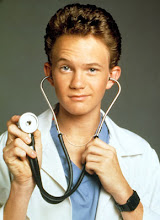"So what does she have?"
"I don't know for sure, but--"
"You need to be more confident about your diagnoses."
"But I don't have enough experience to know--"
"You know more than you think you do."
"But I've never seen it present exactly like--"
"Trust your gut."
"I don't."
"You need to."
"I think she has leukemia."
"Okay, don't trust your gut on this one. That's not what she has."
I think it's impossible to be a good resident. Okay, maybe not a good resident, but a great resident. It's impossible to reconcile the fact that we need to actually try to help our patients and the fact that we have no idea what we're doing. We're expected to be able to make correct decisions, in real-time, about treatment and diagnosis and medication, but we have no body of experience with which to support any of our hunches or hypotheses.
An attending sees a patient present with leukemia and he has a mental database of 10, 15, 20, 50 cases he can compare it to. Patients who presented with these symptoms who had it, patients who presented with these symptoms who didn't, etc. It's obvious to most attendings what the first-level hypothesis is going to be. Patient comes in with headache, chest pain, whatever, there are ways most patients present with different issues, there are subtleties to the pain, to the discomfort, to the set of complaints, and after a while, you learn them. When your set of comparables is big enough, you can trust your instincts, you can assume you have some sense of what's going on and while you're always going to want to back up your assumptions with test results and exclude the other possibilities, you can assume you're usually in the ballpark.
But for me-- and for just about any intern or resident-- our sample size for any given set of symptoms is approaching zero. Someone comes in with the textbook signs of whatever-- and even then, I don't know that I can trust my instincts, because I've seen it in person once, and there's a difference between reading about lower-quadrant pain and seeing what that actually means in a patient.
If a "real" doctor trailed us all day to interpret, I might have a chance. It's actually great when the attending spends hours and hours in rounds with us, because we get a chance to see how they think, to see how they process the symptoms, what questions they ask, what they're looking for. But most of the time, we don't have anyone holding our hand-- we just have ourselves, and we're supposed to be making the right calls-- and we're reprimanded when we don't. But I have no idea what those right calls are. And if I trust my instincts, my instincts are sometimes going to be wrong. Not because I'm not smart but because my experiences are limited to what I've had the opportunity to see. And that's not much.
So when the attending pulled me aside this morning to ask why we didn't do x, y, and z to the patient who "obviously" has a subdural hematoma-- well, it wasn't obvious to me because I've seen one of them, and it didn't look like this-- and even if it's obvious to an attending, and obvious in retrospect-- now I get to beat myself up over a situation where I don't know that I could have done any better than I did. I didn't "miss" anything-- I just didn't know what to look for, and can't possibly be expected to know.
Which isn't much comfort for the patient or her family.
Wednesday, April 28, 2010
Subscribe to:
Post Comments (Atom)

I work in a factory that makes simple flat plastic sheets to print signs on. There are probably under a hundred variables that cause problems -- temperature settings, different plastics, nip roll tightness, bolts that control the plastic flow.
ReplyDeleteBut even here, it's not possible to have a "mental database" of things that go wrong. The top twenty problems, sure. The ones that happen every three months or so -- maybe, after several years of experience. I personally can't even remember these and keep a notebook. (I would do this if I were you, knowing my memory. I'd maybe start with something like the WebMD symptom checker and every time their entry for "swelling" didn't help me, I'd add a little note like "If swelling looks like X, subdural hematoma.")
The thing is, the reinforcement is so far apart, and you often never successfully solve the problem anyway, and the wrong solutions you tried tend to wipe out your memory for the right one, and... I can't even imagine how much worse it must be when you're dealing with humans instead of flat plastic sheets.
I think we need to replace the human memory with a Wikipedia-like solution. You should be able to take a picture of that swelling, put it in a TinEye.com-like tool, and find a wikipedia page where people talk about similar swellings they saw and what they did. Hopefully as fast as it takes me to look up a problem in my notebook, because you don't have time to research everything.